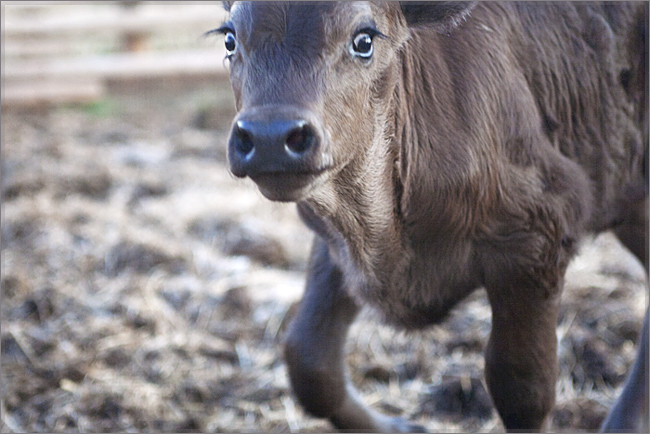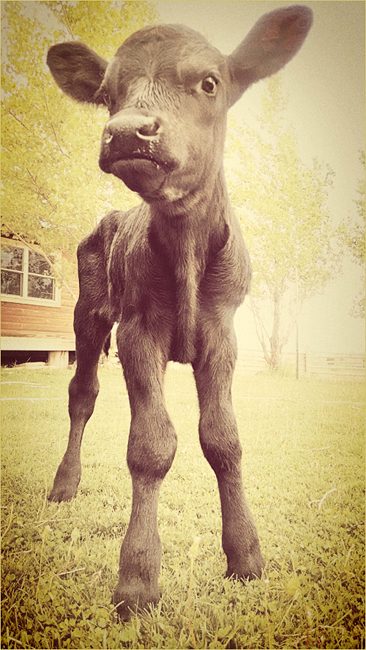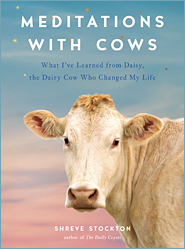Wild Thing
I am convinced that Leila is a barrel horse trapped in the body of a cow. She loves to run and race and turn tight corners at high speeds. And she loves to kiss. It’s still very difficult to get photos of her – she’s either running at top speed or in my lap.
She and Jupiter have become fast friends. Most black Angus (Jupiter’s breed) have pure black ears, but Maia has red-gold edges on her ears – Jupiter inherited them, and they match Leila’s.
Leila’s coat is strange and amazing. She is still every color: black (stripes down her back and belly, and around her eyes, mouth, ears, and hooves), gray and silver (the insides of her legs), brown and red (her head and sides), and pale blond (her neck and chest). Wild.
It’s been a very strange year here, a strange year for me. So many contradictions that actually aren’t; everything in everything. I doubt my words make sense – I’m still making sense of it all – but Leila is an embodiment of chaos that is actually pure love, and all the things that appear to be impossible contradictions that are actually perfect puzzle pieces working together.
Leila Francesca
It has been really hard to get proper pictures of Leila! Part of this is the weather – photography takes the back seat when it is 107°F at 10am and there are a day’s worth of chores (and milking!) to cram into the few cool hours at dawn and dusk.
And part of this is Leila – she is far too excited about being in a body to keep that body still for a photograph! She shows off with a few rounds of little bucks, all four feet leaving the ground at once, then races up to nuzzle my face and neck – she is like a little puppy! Our new favorite trick is for me to sit on the ground and scritch her chest between her front legs; she will then reach over my shoulder and scritch my back with her baby teeth.
When I step away, hoping to fit her into the camera frame, she dashes over.
Most of my photos look like this:
Daisy is so in love.
Thank you for the suggestion of a middle name.
I’m off to milk!
Under The Moonlight
On Wednesday, Daisy looked like she was getting very close to calving. I checked on her a dozen times throughout the day; each time, all she wanted was more hay and she didn’t show any of the telltale calving signs – the cocked tail, the mama moo, licking her belly. Mike and I went out to dinner and when we got home, I was ready to crash – I had been getting up at 3 and 4 am all week to catch up on office work – but first I went to check on Daisy one more time. And lo and behold, her tail was cocked, she was licking her belly, and mooing the mama moo. No sleep for me!
It was obviously still very early in the process, so I laid down on Baby who was chewing his cud in the adjoining corral and let her be for about an hour. Towards the end of that time, she lay down and really began to push, but then she stood up again. I went over to check things out, and saw a hoof sticking out (this is normal). But I was looking at the heart-shaped bottom of the hoof rather than the shiny smooth top. It was a backwards calf, again. And my vet was out of town.
I cried. I did. I was just so frustrated and sad and tired of everything being so hard and heartbreaking. The last calf Daisy had was backwards and though it was born alive, it died five days later. And the whole thing was extremely hard on Daisy, physically – it took her over a year to recover and get pregnant again.
I called Mike and by the time he got to the corral, the hoof had receded back into Daisy (this is also normal), so we gave her time alone to walk around and get further into labor while we figured out a plan. Mike has pulled dozens of calves over the years – sometimes a heifer needs assistance with a normal birth or a calf is too large for a cow to do it on her own. But he has always taken backwards calves to the vet because they are potentially fatal for the calf. And my vet happened to be in Colorado.
The danger with a backwards calf is that the head comes out after the umbilical cord breaks – and when that happens, the baby is compelled to take a breath. If it takes a breath while its head is still inside, it will suffocate. When pulling a normal calf, you can take your time throughout the pull (within reason) because the head and front legs come out first. With a backwards calf, you have to power through an already awkward maneuver to get the chest and head out as fast as possible.
Mike did not want to pull this calf. He was so concerned that he would fail and the calf would die, so he started brainstorming this person or that person to call to come do it, until finally I said, “Mike, you know the mechanics by heart. You’re physically in better shape than any of those people. I trust you more than I trust any of them. And I’d rather have something go wrong with you than go wrong with one of them. We’ll do it together, and I believe we can do it.”
And so we went up to Mike’s house to get the calf pulling equipment, which consists of a small chain that loops around the two presenting feet and a large grooved bar that hooks to the chain and braces against the cows hindquarters. Once the chain is attached to the calf’s feet and the bar, you ratchet out the calf. It sounds barbaric, but I think it’s less gnarly than forceps (which happens to be how I was delivered).
While Mike was gathering the gear, I saw the top of the moon peeking up over the mountain. Since Frisco died, I’ve been able to feel him when I see the moon (and only then). As the moon rose into sight, I asked Frisco to please help us. To help the calf, to help Daisy, to help Mike and me.
Back at the barn, we did a dry run with my wrists in the chain to make sure the calf puller was working perfectly. I gave Mike one last pep talk. We put Daisy in the head catch to stabilize her, and got the chains around the calf’s hind legs which were now both visible. Mike started ratcheting, slowly at first and then quickly after the hips, and when the calf’s torso emerged, I grabbed it in a bear hug and pulled hard with Mike and the calf slid out – alive!
We laid her head-down on a slight decline and I immediately suctioned out her nose and mouth. Mike brought over the oxygen tank we keep on hand for emergencies and while I held the oxygen mask over the calf’s nose, Mike let Daisy out of the head catch and she rushed over to lick and lick and moo to her new baby. After a few minutes on oxygen, the calf moved her head away from the mask, clearly done with it and ready to sit up as Daisy licked her dry. Soon, the calf was trying to stand, and licked her lips and the air, ready for a teat. Wobbly, as newborns are, and with extraordinarily long legs, it was a bit tricky for her to grab a teat – she was so tall, and Daisy’s full udder hung so low! With a bit of assistance from Mike and me to guide and stabilize her, she had her first meal at 2am. We all were feeling very happy and ready to rest.
I was still nervous, since Daisy’s last calf was born alive but didn’t make it, but I’m not nervous anymore. Leila (which means night in Arabic) is so full of life! She bucks and hops and races in circles around the corral and runs up to me for for kisses and pets. She’s gorgeous – proper pictures coming soon – and though she appeared pure black when she was wet and slippery, she is actually every color. Her hair is black, gray, silver, brown, and red. She looks like obsidian, like oxidized silver, like moonlight.
The Rooster Pouf
It turns out that one of our baby poufs is a rooster! Chloe, as I’ve noted before, is obsessed with chickens, and the new ones in particular.
Exhibit A:

Back in May, when Siouxsie & The Bantams were transitioning outside, Chloe managed to cram herself between the rock wall and their enclosure. She just wants to be as close to them as possible.
For the most part, the chickies ignore Chloe because they are so used to her hovering around. But the rooster pouf holds his personal space in high regard and isn’t afraid to make that clear. This game (according to Chloe) / dance (according to me) / fight (according to the rooster pouf) has been taking place every morning for the past week or so, and I managed to catch a bit on video… before they knocked me over with a feather.
Chloe & Rooster Pouf from daily coyote on Vimeo.
Hey Jupiter
A new baby has joined the Farmily. Maia, Daisy’s adopted calf from 2012, had her first calf a few weeks ago. I’ve often said that cows are the best mothers, but sometimes they aren’t. And Maia has been the absolute worst. She had an easy birth on a sunny afternoon, but immediately after was like, “OK, I’m done, gonna hang with my friends now,” and walked off, completely ignoring her calf. When he followed her and tried to nurse, she kicked and headbutted him. Not OK, Maia!
With Daisy’s help, I walked Maia to the corral while Mike brought the calf down on his 4-wheeler. (Maia did not want to leave her gang but she was willing to follow Daisy, and Daisy is always happy to follow me because she knows she gets special treats when she does.) At the corral, we put Maia in the squeeze chute – which gently confines a cow – and allowed her calf to safely nurse, which he did with gusto as Maia glared into the middle distance. When we let her out of the chute, she turned on her calf again. It was obviously too dangerous to leave them together for the night, as a cow can kill a calf if she is aggressive and determined to keep it from nursing.
By that time, the sun was setting and the weather was turning and I couldn’t bear the thought of leaving a newborn alone in a storm, even in the shelter of the barn. So I took him home with me, made a nest of blankets in the bathroom, set my laptop on the toilet seat, and mainlined Orange Is The New Black while the calf slept curled beside me with his chin resting on my thigh.
The next morning, Jupiter bounced around the yard and played with Pita while I had tea; then we took him down to the corral to repeat the squeeze chute maneuver for breakfast. We kept the two of them close but separated during the day – together in the corral but with a wood fence between them, so they could smell each other and communicate, but Maia couldn’t harm him. When we put them together in the evening to see if Maia had decided to love him, Maia went right back into attack mode. Back in the squeeze chute she went, so the baby could dine. And back to my house he went, because another evening storm blew in.
Day three was a repeat of day two, with no change in Maia’s attitude. We’ve had other cows start out as reluctant mothers, but usually two days with the squeeze chute is all they need to get accustomed to nursing and fall in love with their calves. Maia’s behavior was kind of baffling (there was no physical reason for it), and getting very high maintenance, and not fair for the baby. So, on the fourth morning, we hobbled her. Hobbles are like prison leg shackles made of leather that go on a cow’s hind legs. Maia could still walk and lie down, but she couldn’t run or kick.
Maia was furious, but Jupiter was safe to stay close to Maia to bond and nurse when he wanted to, and I tried to soothe Maia with pans of Daisy’s special treats and long brushing sessions. After five days – because she was still antagonistic towards Jupiter for four solid days – we took the hobbles off and sat back to see what would happen. Free from the hobbles, Maia allowed Jupiter to nurse IF AND ONLY IF she was also eating. Begrudgingly, and not without agitation, but she no longer assaulted him. If she wasn’t eating, however, Jupiter couldn’t either – she’d kick him away, though not nearly as viciously as she had been.
And finally, FINALLY, at the end of last week, I spied Jupiter nursing while Maia stood calmly, without any food in her mouth. We might have a love match, after all.
« go back — keep looking »















